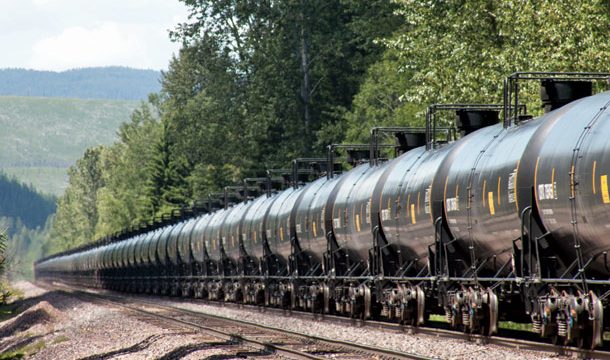Firefighters Dispel "Voodoo" Myths Around Bakken "Bomb Train" Crude

A BNSF freight train carrying tank cars back to the Bakken region of North Dakota rolls through Nyack, east of West Glacier, in June. Justin Franz | Flathead Beacon.
“We’ve got people running around saying that it’s like a bomb on wheels,” Chauncey Naylor, director of training and fire and emergency response for Tyco Williams Fire & Hazard Control, is quoted as saying in the Summer 2015 issue of Industrial Fire World magazine (scanned version below). “It got us thinking that we ought to check into this stuff because we might be called in to deal with it.”
He’s talking about Bakken crude oil and the political furor which has emerged around the shipment of it by rail. Activists have taken to calling rail cars hauling North Dakota crude “bomb trains,” and certainly a few incidents have given the public reason to be concerned. A deadly 2013 explosion in Quebec, and a 2014 explosion in Casselton, North Dakota, have people worried.
[mks_pullquote align=”right” width=”300″ size=”24″ bg_color=”#ffffff” txt_color=”#000000″]“Everything we looked at, such as the flammable range, fell right in the range of being typical crude oil,” Naylor said. “But because of about five events in a short amount of time, it has gone from Bakken crude to voodoo crude.”[/mks_pullquote]
Understandably so.
But because oil and oil and cannot be discussed without political gamesmanship, there have been a lot of crazy claims made about Bakken crude with little substantive information to back it up. Thus the “bomb trains” stuff.
So what did Naylor and his organization do? They got their hands on 3,000 gallons of Bakken crude – they were offered access to oil directly from a well but opted to get some out of a pipeline in Cushing, Oklahoma – and they set it on fire to see if it was any different.
The results?
“Everything we looked at, such as the flammable range, fell right in the range of being typical crude oil,” Naylor told IFW. “But because of about five events in a short amount of time, it has gone from Bakken crude to voodoo crude.”
In other words, politics happened. The people who hate oil saw a string of oil train derailments as an opportunity to block oil shipments.
But out here in the real world, it turns out that putting out a fire resulting from Bakken crude is about as difficult as any other type of crude:
Tactics to extinguish the flames hardly qualified as cutting edge technology. Rather than bring big monitors to bear immediately, firefighters first approached the burning tank armed with two hand lines using 95 gpm nozzles, making a “pretty sloppy application,” Naylor said. Deliberate rookie mistakes included breaking up the foam blanket and plunging the foam beneath the surface of the crude.
“The idea was to act like people who had never approached this voodoo crude before and are a little nervous,” he said. “We’re all over the place. We’re just chasing fire. But the fact is we are getting flame collapse.”
Still, the C6 foam successfully formed a quarter-inch thick film across the crude oil surface. The fire was extinguished in 3 minutes, 16 seconds.
When the oil industry itself has produced research indicating that Bakken crude oil is no more dangerous than other types of crude oil they were accused of being self-serving. And it is certainly fair to take anything the oil industry tells us about its own products with a grain of salt. They certainly have skin in the game.
But here we have a group of firefighters – people’s whose lives hinge on understanding how material burns – telling us that, after testing, Bakken crude oil is no different from other types of oil.
That speaks volumes.




